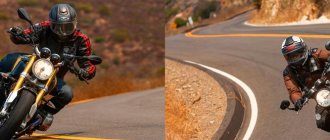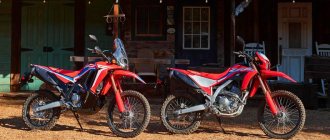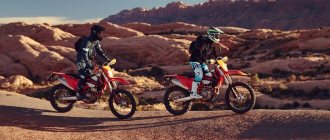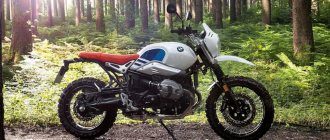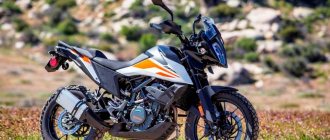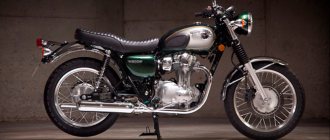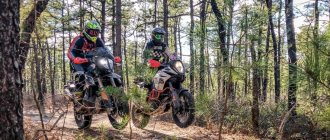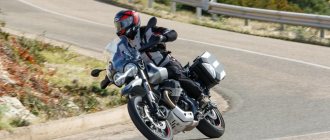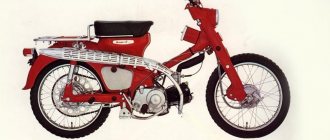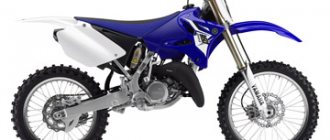Zero Motorcycles SR/F 2020
Zero Motorcycles is once again making a move to dominate the on-road electric bike segment with the announcement of the new SR/F model for the 2020 model year. Top components are installed on a new chassis with a new electric motor and battery pack, and the bike has increased both available power and range compared to the previous top-of-the-line Zero SR electric road bike. At the same time, the design of the Zero SR/F is not much different from the usual gasoline naked motorcycles, which makes this model even more interesting, especially for adherents of classic design.
Zero SR/F 2021
Designing the device from scratch, the designers created a sleek, functional design with a powerful battery at the center. It's a far cry from the clunky look of the old Zero S or SR models. But you know what's interesting? I can't help but think it looks similar to the 2021 Honda CB650R Neo-Sport Café. Even the Boardwalk Red paint has something in common with it, especially the gold wheels.
And here it stands in front of me, a new, technologically advanced motorcycle, and all I can think about is how similar is it to a Japanese mid-size bike? Perhaps that was the idea, because its appearance is very similar to modern petrol necks, and this may well make it more attractive to buyers. Its sleek, compact silhouette with a somewhat aggressive front end and stubby tail has a modern, on-trend streetfighter flavor. The design of the new product differs from previous Zero models and is more reminiscent of a traditional motorcycle.
Design Zero SR/F 2020
The thin front fender sits between the upside-down fork legs, above which sits a single LED headlight with low beam, high beam and daytime running lights on either side. The usual Zero turn signals peek out from behind a small windshield, seemingly hanging over the headlight. The ZF 14.4's large finned lithium-ion battery is a stressed member of the frame and adds much of the visual weight to the bike's appearance. The battery is framed by a steel frame cage, and the Z-Force 75019 electric motor with radial air-cooling fins is hidden behind the battery. Mounted to an aluminum alloy subframe is the seat and a 12-volt battery for the standard on-board electrical system (including an accessory socket and on-board computer with cellular communications module). On top of all this is a typical shaped false tank, which houses the glove compartment, two USB ports and a separate compartment with the main charging port. The Level 2 charger comes as standard.
Equipment and ergonomics
The bike not only looks beautiful, but also comes equipped with top-end electronics and other components such as the 43-gauge Showa BP-SFF fork with full tuning and a 40mm external reservoir monoshock at the rear, also from Showa and also fully customizable.
The Zero SR/F comes in two versions. Our copy of the more expensive Premium version is equipped with a fast 6-kilowatt charger (the standard one is 3-kilowatt), thanks to which the battery charges twice as fast. The top version is also equipped with heated grips, the already mentioned fairing-wind deflector and aluminum weights at the ends of the handlebars. Otherwise, both versions are the same, both equipped with Bosch's MSC stability system with tilting ABS, traction control and traction control. All of these systems can be customized to suit your preferences by selecting one of four riding modes (Eco, Street, Sport and Rain) using the switch on the left console or from the new Zero app on your smartphone.
Sit in the seat and the SR/F immediately feels at home. The low-profile handlebars sit you in a slightly forward-leaning position just above the raised tank, just like on any typical naked bike. The stock saddle has a height of 79 centimeters, but our example was equipped with an optional low seat height of 77 cm. At 175 cm tall, I can easily stand with both feet while sitting on it (there is also a high saddle, it has a height of 81 cm). Zero representatives, however, said that the saddle is still standard, and I sit comfortably on it because the motorcycle is narrow, which was achieved, among other things, thanks to a unique low-profile concentric pendulum located coaxially with the engine. The seat is quite flat, but quite comfortable for short trips, and has a small passenger section that forms a step for the driver. And you will need it the first time you turn off the gas!
Do not try to “start” it with the button located under the kill switch. It's not the starter, it's the cruise control.
Just turn the key in the ignition, wait a couple of seconds while the system starts up and tests the hardware... and the SR/F is ready to drive, although it remains completely silent.
So I, after a brief introduction from a Zero employee, quietly opened the gas and went on my first ride in the 2020 Zero SR/F.
I’m posting the first small test of the electric motorcycle (or electric cycle, as you like) Zero SR/F. This is a translation of an article from the website motorcycle.com The original article is here www.motorcycle.com/manufacturer/zero/exclusive-2019-zero-sr-f-review-first-ride.html The topic is very interesting to me. This is the first motorcycle that looks like a normal one, and although it will not disrupt the market, as the creators promise, it has taken a step forward. Not Tesla yet, but already something. 2019 Zero SR/F Electric Motorcycle Review This motorcycle is the culmination of a $300 million investment and 13 years of development. This is the best electric motorcycle currently available. It boggles the mind that mass-produced, road-legal electric motorcycles have only been around for 10 years. In 2009, Zero Motorcycles launched the Zero S and ushered in the era of electric two-wheeled street transportation. That year, the Zero S wasn't the only electric motorcycle in production, it was the only electric vehicle in production at all. To say that Zero was ahead of its time would be an exaggeration, but this early start gave the company time - 13 years from its inception - to become, as its marketers claim, "the world leader in electric motorcycles and electric powertrains." If your product has created an entire category of vehicles, that's more than PR fluff. This is an indisputable fact. Other motorcycle manufacturers have noticed the trend and are entering the market. BMW has its own C-Evolution scooter (review here www.motorcycle.com/manufacturer/bmw/2018-bmw-c-evolution-review.html). Energica has created a niche in the luxury electric vehicle market with its Ego, Eva and Eva Esse Esse 9 – and has achieved fame and success with the FIM, becoming its supplier for the MotoE racing series, which will tour with MotoGP in 2021. Lightning Motorcycles, the luxury brand whose LS-218 superbike has taken Bonneville and Pikes Peak by storm, recently announced that its Strike model will be unveiled next month, while Harley-Davidson has finally announced an August 2021 launch date for its Livewire electric model. Lest you think that simply producing electric motorcycles guarantees success, consider the demise of Alta Motors. Meanwhile, Zero has been in this segment longer than any other manufacturer and is creating this market itself. ignore the ugly plastic panel on the side
With all this in mind, I met with Zero representatives to get my earliest insight into the 2021 Zero SR/F. So, while the rest of the world learns about the StReetFighter Zero in a press release, this article will give you impressions of the actual ride. But first, a little background. How many motorcycle manufacturers will tell you that the bike they produce is one of a kind and the one they always wanted to make? The ICE motorcycle market is so mature and segmented by marketing niche that this statement is almost unheard of. However, the electric motorcycle market is still very young, and SRF represents just such a statement. This third generation Zero is the generation where the myriad requirements for an electric motorcycle vision can finally come together and become a reality. According to Abe Ashkenazi, Zero's chief technology officer, the first generation of Zero motorcycles focused almost exclusively on the powertrain. The main effort was spent on answering the question: “How to make an electric power unit work?” The result was the Zero S, released in 2009. For the first time, Zero made a clay model of their motorcycle. The designers combined 3D printing of the chassis and motor components with clay to realize an idea that came from the digital world.
The second generation Zero S appeared in 2012/3 and looked more motorcycle-like. So, in addition to increasing battery capacity and engine power, the Zero has also been upgraded to Showa suspension, J. Juan braking components, Bosch ABS and Pirelli tires. However, with so much mental effort devoted to the mechanical parts of the device, design was left for later. “We had a battery and we had this motor,” Ashkenazi noted. “They were integrated from a technical and development point of view, but from an aesthetic point of view they had to wait.”
With SR/F the decision was made to take everything they had learned with the first two generations and start from scratch. Ashkenazi sums it up: “This time we got everything from the very beginning: industrial design, mechanical engineering, energy, electrical engineering. When we started this project, everything was at hand, there were no restrictions. How will you use this?” When the dust settled, the only parts of the bike that remained from the previous generation were: footpegs, mirrors, turn signals, electronic throttle, handles, handlebar weights, wheel speed sensors and magnets, horn, reflectors and a kickstand (I just listed the whole bike, just kidding)). As a result, the 2019 Zero SR/F is a motorcycle that looks, in my opinion, more like a full-size motorcycle than any previous one. “The beauty of the bike is impressive,” says Ashkenazi, “but the beauty of the inside of the bike is much more impressive.”
Accumulator battery. According to Sam Paschel, CEO of Zero, the first three things people ask about an electric motorcycle are always: range, how long does it last, and how long does it take to charge? This should come as no surprise to those who are at least somewhat familiar with electric vehicles in general and more specifically with electric motorcycles due to the size and weight limitations of the two-wheeled platform. While almost every subsequent motorcycle in the Zero model line improved the answer to the first two questions, compatibility with a standard 110v outlet (in the USA 110, not 220, somehow burned the X box because of this, approx.) on the previous bikes generation meant that any improvement in battery capacity was counteracted by increased charging times. Zero has solved this problem with the Charge Tank Level 2, which can fit into the space of the previous generation's gas tank - and you can also purchase additional chargers to speed up charging times - but these options are expensive and potentially bulky. The most elegant solution would be to build the charger into the bike itself. Level 2 charging is standard for SR/F!
Note: In the US, charging stations are divided into power levels of 1,2,3 (Level 1,2,3). For those interested, you can read more here: elektro-mobili.ru/tipy-zariadnykh-ustroistv-dlia-elektrokarov/
For the SR/F, Zero built this Level 2 charger right into the base configuration of the bike, catering to people who ride a lot and charge often. Since the capacity of the built-in Z-Force Li-Ion battery remained at 14.4 kWh, the use of 3kW Level 2 charging in the standard SR/F reduced the full charge time by half from 9 hours to 4.5 hours. (Note: Typically, the last 10% of a battery charge takes about half an hour, so a 90-95% charge will take about 4 hours.) While the SR/F still comes with an adapter for 110V power, you will need to plug in the SR/F to 220V to take advantage of the charger upgrade. But consumers who choose Premium charging for the SR/F will receive the ability to charge at 6kW, significantly reducing the charging time to as much as 2.5 hours from 0 to 100%... For the super demanding SR/F owner, an improved battery will allow charging this year with 12kW, which means only an hour to charge from 0 to 95% and to 100% in an hour and a half. However, the charging station must be able to provide that much power - many simply don't have it. The basic SR/F gets a 3kW charge ahead of the picture, the premium modification gets another one at 3. The 6 kW charging accessory, the one on the tank, will be available later.
At this point, some electric-savvy readers will want to know why Zero hasn't included Level 3 fast charging compatibility. The reasons for this lie in the current state of charging infrastructure in the US (and much of Europe), where 90% of charging stations are Level 2. Related with the scarcity of Level 3 stations, the decision was made to stick with Level 2 – but fast Level 2. As for the potential of Level 3, Paschel says: “We will see in the future how Level 3 will develop and of course we will offer our customers the best solution.” Naturally, I would assume that this solution would come in the form of an updated charger. Before I continue, I would like to address concerns regarding charging time. As an EV owner, my daily charging experience is that it's no more than the time it takes me to plug in the Level 2 cable in the evening and unplug it in the morning - essentially less than a minute. Daily users of electric motorcycles, I imagine, would do the same and not give a damn. I suppose this is a good time to mention the SR/F's claimed range of 161 miles (259 km) in the city (the Power Tank option increases it to 200 miles - 322 km), 82 miles on the highway (132 km) and 109 miles in city mode /highway (175 km). Pat yourself on the head if you were paying attention and noticed that it's 10% smaller than the regular SR and that's due to the bike's higher weight and larger tires. For more than 90% of my motorcycle use needs, the stated SR/F figures will be sufficient. If you're looking for a bike to ride just in the mountains or for weekend touring or long-distance riding, the SR/F - or any electric motorcycle - is not for you. With that said, you can be sure that when I get the test bike into my garage, I'll be giving it the same test ride on the Angeles Crest highway that I've given all the other ebikes I've tested to see how it handles sporty riding. in the mountains. The fins on the battery compartment are designed to equalize the temperature of the cells. But wait, we're not done with the battery yet. If you looked closely at the photos of the SR/F, you'll notice that the battery pack looks much less like a box. In fact, now you can see new cooling fins of the radiator. An even closer look at the frequency of these edges will reveal that there are more of them in the center than at the edges. The reason is simple. The cells located in the front and back have more contact with the surrounding air, and those on the side have less. More dense ribs in the center are designed to stabilize the temperature and make it more even. You'll also notice that the fins are vertical rather than horizontal because they do their job when the bike is stationary and charging.
Motor and controller. The battery is the heaviest component on the SR/F, followed by the motor. With this in mind, it was placed as low and far forward as possible to keep the center of gravity low. This location also allows the motor to be cooled without fans. Instead, the lower part of the body scoops air from underneath the battery compartment and directs it to the cooling fins of the controller and motor. The fairing takes in the air flow and directs it to the motor and controller
The SR/F engine has been significantly updated. Firstly, it is 3 cm wider, but the most important thing is the filling. In addition, it cools better with the help of rounded fins (in the picture). Finally, the power jumped significantly. The ZF75-10 engine produces 110 horses and the SR/F is the first bike from Zero to achieve the figure of 100 horses. For comparison, the ZF75-7R engine in the previous generation SR produced 70. Another interesting fact is that the ZF75-10 achieves its new top speed of 124 mph (200 km/h) thanks not only to the engine's punchy power, but also to increased revolutions per 1000 rpm up to 7500. With this power, the controller draws 900 amperes from the battery. To ensure that the battery does not wear out quickly under full load from the controller and motor, the battery itself is capable of producing 1200 amps. To cope with the heat from this amperage, the innards of the motor are encased in a thermal compound that surrounds the copper coils on the stator and fills the space of the motor, which in turn conducts the heat to the radiator fins. Rounded cooling fins and swingarm. We'll discuss this unusual design later.
This motor has come a long way from previous models, which could not overcome the 80 mph limit to protect against overheating. Now during development, the ZF75-10 was torture tested at 120° (49 Celsius) temperatures in Death Valley and the extreme stress of the race track. (Note: SR/F at two miles beat the previous one by 5 seconds with the same rider) This diagram shows how PowerPivot allows the drive belt to remain at the same tension.
One of the most interesting features of the motor is that the drive shaft of the motor is also the location of the pendulum pin (not sure of the translation). This serves two purposes. First, it allows the bike to be very narrow, making it easier for shorter riders to reach the ground. Secondly, the tension remains constant throughout the entire suspension travel. This way the belt is very well tensioned and does not sag. (crooked paragraph, translated as best I could, correct in the comments if anyone understands) Chassis With such a unique interaction between the pendulum and the motor, it is not surprising that the motor and battery are heavily loaded. A steel lattice frame wraps the battery compartment. A fully adjustable SFF Showa fork with stays goes to the 17-inch front wheel. At the rear, a fully adjustable shock absorber interfaces directly with the steel swingarm. Both cast aluminum wheels get Pirelli Diablo Rosso III rubber – 120/70-17 at the front and 180/55-17 at the rear – another step up from the previous generation.
Braking is provided by components from J.Juan. Radial, 4-piston front calipers squeeze 320mm diameter discs that are custom-made to match the wheel design. Rear brakes - 240mm disc, single-piston caliper. We'll look at ABS in more detail in a minute. A cast aluminum subframe holds the seat at a height of 77 cm and houses the 12V lithium-ion battery. The seat is comfortable and easy to reach the ground from. You'll be glad there's a bolster behind you when you ride this bike.
Yes, the SR/F has a 12V battery to power the onboard systems. In the past, the only power source was a 100V battery and this added unnecessary complexity. On the SR/F, the 12V battery acts as a buffer in the system to power the electronics, and the 100V battery monitors the 12V battery and charges it as needed.
Electronic heaven!!! To manage the many interconnected systems that SR/F has, Zero engineers created the Cypher III operating system to act as a central hub. Cypher III integrates the 12V system, charging system, battery monitoring system and battery itself, controller and motor, Bosch stability control system, TFT instrumentation, bluetooth and cellular module. Ufff, that's it!
The button at the bottom is cruise control, and there are also heated grips
Bosch MSC (Motorcycle Stability Control) is the first system of its kind in an electric motorcycle. It monitors all the main control systems of the bike, namely: ABS, corner ABS, traction control (or traction control, as you like), a system of protection against excess torque at start (drag torque control) - all of which are regulated by riding modes (Eco, Street, Sport and Rain) and there can also be up to 10 programmable custom riding modes. Using the TFT monitor, riding modes can be easily set via an intuitive menu system with a switch on the left handlebar or, as the Zero did on previous models, directly from a smartphone app.
Cellular Communications Zero, in collaboration with Starcom Systems, has created the first affordable “networked” motorcycle - let's call it that. The cloud-based cellular system allows the rider to remotely interact with the SR/F in five key areas: bike status + alerts, charging options, ride relive & share, custom modes and system updates. Let's explain now. Some information received from the connected motorcycle: remote control of charging time and setting a target charging notification.
Bike status includes information such as the location of the motorcycle, all motorcycle statistics, state of charge (SOC), charging progress information, time to full charge, mileage to discharge and possible system updates. In addition, SR/F also has alerts. For example, the owner will be informed if someone moves the parked bike, charging is completed or interrupted, the charge level is low during storage, and a new system update is available. In addition, the driver will be able to set an alert when the SR/F reaches a certain charge level (say, for driving home) or designate the start time of charging, for example, to charge at a cheap night rate. Other customizable remote features are the ability to customize the color and brightness of the dash or, as mentioned earlier, create custom riding modes via the phone app.
View all the important statistics for your trip.
Because cloud connectivity makes SR/F part of the internet, Zero has included social sharing capabilities within the app. After recording a trip, the information can be shared with other bikers and exactly to the extent that the driver wishes. All information from the angle of the bike to the road and the speed at each section can be shared so that the driver can relive these moments of the trip. Drivers also have the option to keep all their information anonymous and can be confident that no one is tracking their trips or using their information without their permission.
On the Road After a technical briefing, Zero provided us with a pair of premium-spec SR/F bikes fresh off the production line in Scotts Valley, California. The roads around Scotts Valley and Santa Cruz are designed for motorcycle riding. So, after a short drive out of town, we reached roads suitable for testing. Even in black and with plastic panels on the sides the bike looks awesome
My first impression of the SR/F's appearance is that it looks much more like a full-size regular motorcycle than its previous SR and DSR models. I have nothing against them, but throwing my leg on the bike immediately confirmed my thoughts. The look and feel of the SR/F speaks volumes about the integrity of the motorcycle. It feels cohesive and the fit and seat height were in line with other streetfighter bikes (naked, road bikes, you name it). In Street mode, throttle response is quick but not harsh. The acceleration curve (or is it the power delivery curve? Idk) does not reach full power, as in Sport mode, but you can only notice this after unscrewing for a long time. There is plenty of torque for most driving situations. For reference, both modes have different MSC settings for normal use and more aggressive riding respectively. The landing position on the bike is moderately aggressive, just right
The most noticeable difference between the two modes is how the regenerative braking is applied when the throttle is closed. In Sport mode, regenerative braking doesn't kick in until the throttle is just a few degrees away from being fully closed. This is necessary for more precise dosing of regenerative braking and a clear throttle response that active drivers prefer. In Street mode, braking is more proportional and increases as the throttle approaches full throttle. This allows the driver to dose the regenerative brake depending on the driving situation. The only trade-off is that acceleration isn't quite as punchy in this mode. (I can't wait to get this bike for a long time so I can play with the regenerative braking settings myself and see the results.) Instant acceleration is exactly what people expect from an electric motorcycle. And the SR/F doesn't disappoint. Acceleration is strong throughout the rev range. Yes, if you're used to riding an ICE bike with peak thrust in a certain rpm range, you may be sad for that very moment when the bike seems to blow at the speed of light, but that's what you get at any other speed with the SR/ F, it's worth it. Instant torque sticks.
The monitor is customizable, but this display is most convenient
On our test ride I was able to reach a top speed of 200 km/h. Due to the fact that the speed is limited by software, no drop in power is felt when the speed reaches two kopecks. You just dial two and stay there. All you hear on this naked SR/F at this speed is the wind, while lower speeds come with a futuristic rumble that I find enjoyable. With its slightly forward-leaning riding position and its enormous power, the SR/F is the perfect machine for winding asphalt roads. The steering is neutral, and neither highway braking nor corner braking throws the SR/F off its line. The wide handlebar is convenient for taking a series of turns.
The system menu is intuitive and controlled with one button
The quality of the roads we drove on varied from perfectly smooth, like a billiard table, to very bumpy. Almost every bike rides well on the smooth, but here I was impressed by how well the Showa suspension handled bumpy surfaces - sometimes with potholes right in the middle of corners. I'm sure riders of different sizes will want to play with the suspension settings, and the base settings were almost perfect for my 89kg weight. When it came to deceleration, the J. Juan brakes provided just the right amount of power and lever pull. Although the roads were muddy from recent rains, I didn't feel the tires slip when braking or accelerating. I actually tried to burn the rear in the gravel, but after spinning the rear tire for a split second, the SR/F simply rolled out of the gravel. Very cool traction control (traction control).
Production ramp-up
My biggest complaint about this test drive of the SR/F was that the drive was too short, but that's always the case when an exclusive ride is on an extremely tight schedule. Our ride was about 70 miles, including city traffic, mountain climbing, repeated photo shoots, a couple of high-speed sections (including top speed climbing), and highway riding. After all this we came back with a charge level of 30%.
So how good is the Zero SR/F? As soon as I took the helmet off after the ride, I immediately requested it for a long test. There are a lot of things I want to try with custom ride modes. I want to take him on my hell of a ride up Angeles Crest. Most importantly, I just want to ride the bike and see what it's like to live with it. The SR/F is simply the best electric motorcycle I've ever ridden, and I can't wait to compare it to another electric (or two - if available) to understand the current state of the electric motorcycle market.
The “fuel tank”, but in fact the luggage storage box is large and has a USB input for charging. Unfortunately, the trunk lock is located separately from the ignition switch and to open it you need to insert the key into a different latch.
The 2019 Zero SR/F comes in two colors, Boardwalk Red and Seabright Blue, and has a base model MSRP of $18,995. The Premium model costs $20,995, but you get a Level 2 6kW charger (instead of 3kW), a floating screen, heated grips and aluminum handlebar weights. We don't know much about the Lightning Strike bike to date, but we have seen a bike with a similar riding position in Lightning teasers, and given the Lightning's sport pedigree, we expect the Strike to be a fast bike. If the hype is to be believed, the Strike will be significantly cheaper to run than the SR/F, especially with its starting list price of $12,998. As for the SR/F, I personally would be sold on the shorter charging time and opt for the premium package - and even if I mostly charged the battery overnight. The 2021 Zero SR/F will arrive in showrooms in April. Electric motorcycle fans should start lining up for a test drive now.
Full traction from the bottom
As you probably know, electric bikes have almost no increase in thrust as the rpm increases. The electric motor can develop almost full thrust from the very bottom. And it makes almost no sound, except for a subtle whir at high speed and the noise of rubber, which is surprisingly audible against the background of a silent engine. In general, riding a motorcycle opens up from a new side: you can hear birds singing, distant cars, you can hear the brake pads rustling on the discs, the drive belt spinning... You can even hear a slight crunch in the cervical vertebrae when your head leans back when you open the gas. This was a revelation for me: I haven't ridden an electric bike for many years. And Zero has been doing his thing for 13 years, and SR/F is a very obvious success story of these years.
It was raining when I started, and they immediately showed me how to switch the driving modes, setting it to Rain. Half an hour later, the rain stopped, and I switched to Road mode, continuing my journey under the rustle of wheels on wet asphalt. A 900-amp, three-phase controller supplies power to the engine, and a claimed 190 Nm of torque is available with just a flick of the throttle. In Road mode, the engine responds to the throttle somewhat quicker, but not too harshly. Even in this mode, when the throttle is closed, regeneration is slightly felt - active braking by the engine, which during braking operates in generator mode and returns part of the kinetic energy to the battery. In Sports mode, by the way, recuperation is activated only in the last phase of the coasting.
The sensations of acceleration and braking are all good, but it would be nice to know the real power numbers. So I went to the dyno stand with some guys I know who I completely trust.
2021 Zero SR/F on the dyno
The guys, by the way, confirmed my first impression: “Oh, he looks like a new sea bream!” We thought it was no big deal and the Zero's build quality was every bit as good as a Japanese bike, so we put it on the dyno. This is where Zero surprises: the company says the Z-Force's 14.4 kWh battery and air-cooled ZF75-10 AC motor produce 190 Nm and 110 hp peak power. at 5000 rpm in Sport mode. What surprised us was that the dyno showed very close numbers: 101.65 hp. at 4920 rpm and 179 Nm already at 1350 rpm. Not weak!
In Sport mode, the engine delivers everything it can, and we noted a clear difference between Road and Sport modes: the former has more than 30% less power. The Zero hits 100 km/h in 1.6 seconds in Sport mode, all in near-silence. We discussed how the lack of exhaust roar greatly affects the feeling of speed, as well as safety: I almost hit a cyclist while driving to the workshop. He traditionally drove without looking, and of course, did not hear me.
ZERO SR 2021 (used)
We have a motorcycle with a mileage of 59 km. Year 2021, registered. The condition of the motorcycle is new. Among the shortcomings is a small scratch, it does not affect the speed, it is not noticeable. An original windshield is a bonus. PTS available.
ZERO SR is the world's fastest and most powerful production electric motorcycle. Acceleration to hundreds in just 3.3 seconds! Model 2017 with a 50 kW engine.
Even more power and range. Even more impressive dynamics. The Zero SR is a supercharged version of the Zero S electric road bike. It is designed for those who need maximum power and acceleration.
The Zero SR is equipped with an engine with a power of 67 hp. and an impressive torque of 144 Nm! To ensure such performance, the SR electric motor is equipped with special high-temperature magnets and is controlled by a more powerful controller than on the Zero S.
All Zero SR 2021 electric motorcycles are equipped with batteries with a capacity of ZF 13.0 kWh. It provides a range of up to 260 km on a single charge.
The design of the Zero SR is thought out to the smallest detail, the 2021 motorcycle comes only in red, which emphasizes its special status. This model is also distinguished by a larger “ZERO SR” emblem on the sides of the “gas tank”, and in the rear you can see a massive but elegant radiator for cooling the powerful electric motor controller.
Separately, it is worth noting the elegant digital LCD panel with contrasting symbols and a pleasant blue backlight. For “advanced” riders, there is a proprietary application for smartphones, Zero Motorcycles App, which, via Bluetooth, allows you to access all the parameters and settings of the electric motorcycle and customize its characteristics to your liking. This application works on Apple iPhone and Android smartphones. In case of a malfunction, you can use it to send a report to support.
| CHARACTERISTICS | |||
| Model name | ZERO S ZF13.0 in stock | ZERO S ZF13.0 + Power Tank | |
| ELECTRIC MOTOR | |||
| Maximum power | 67 hp (50 kW) at 4000 rpm. | ||
| Maximum torque | 144 Nm | ||
| Type | Model Z-Force® 75-7 - High-efficiency brushless permanent magnet motor with passive air cooling | ||
| Controller | Highly efficient 3-phase inverter with energy recovery function. | ||
| DYNAMIC CHARACTERISTICS | |||
| Maximum speed | 164 km/h | ||
| Acceleration to 100 km/h | 3.3 sec. | 3.9 sec. | |
| ACCUMULATOR BATTERY | |||
| Model | Z-Force® Li-Ion intelligent | ||
| Maximum capacity | 13.0 kWh | 15.9 kWh | |
| Nominal (useful) capacity | 11.4 kWh | 14.0 kWh | |
| Battery life (urban cycle) | 583,000 km | 713,000 km | |
| Charger | Built-in 220V, power 1.3 kW | ||
| Full charge time using built-in standard charger | 8.9 hours | 9.8 hours | |
| Full charge time with external charger Quick 2x (optional) | 5.2 hours | 6.3 hours | |
| Charging time using CHAdeMO charging station (optional) | ~ 2 hours | ||
| POWER RESERVE | |||
| Urban mode (EPA) | 259 km | 317 km | |
| On the highway at a constant speed of 89 km/h | 158 km | 193 km | |
| Combined (city/highway 89 km/h) | 196 km | 240 km | |
| On the highway at a constant speed of 113 km/h | 130 km | 158 km | |
| Combined (city/highway 113 km/h) | 174 km | 211 km | |
| TRANSMISSION | |||
| Type | Single speed belt drive direct from motor to rear wheel, 130T/30T ratio, Poly Chain GT Carbon™ belt | ||
| CHASSIS / SUSPENSION / BRAKES | |||
| Front suspension | SHOWA 41mm inverted aluminum fork with adjustable rebound and compression travel | ||
| Rear suspension | SHOWA 40mm remote reservoir shock with adjustable spring preload, rebound and compression travel | ||
| Front suspension travel | 159 mm | ||
| Rear suspension travel | 161 mm | ||
| Front brakes | hydraulic disc J-Juan, Bosch Gen 9 ABS, floating disc 320×5 mm | ||
| Rear brakes | hydraulic disc J-Juan, Bosch Gen 9 ABS, disc 240×4.5 mm | ||
| Front wheel | Pirelli Diablo Rosso II 110/70-17, rim size 3.00×17 | ||
| Rear wheel | Pirelli Diablo Rosso II 140 / 70-17, rim size 3.50×17 | ||
| DIMENSIONS AND WEIGHT | |||
| Wheelbase | 1448 mm | ||
| Seat height | 807 mm | ||
| Track | 80 mm | ||
| Curb weight | 188 kg | 208 kg | |
| Load capacity | 164 kg | 144 kg | |
| COLOR | |||
| Standard colors | red | ||
| GUARANTEE | |||
| Standard motorcycle warranty | no warranty (used bike) | ||
| SAVING | |||
| Average cost of a full charge (average tariff 4 rubles/kWh) | 33 rub. | 39 rub. | |
At Romanov Motors, we can purchase electrical equipment on credit or in installments. You can buy a Zero motorcycle by clicking the “buy” button or by calling our managers. We deliver in Moscow, Sochi and throughout Russia. The Zero SR electric motorcycle is the best means of transportation. All electric vehicles are provided with a company warranty.
Zero SR/F 2021 for intercity travel
After the “run” on the dyno, I decided to go for a real run and see if the Zero was suitable for long-distance touring. There was a certain risk in this: I charged the motorcycle at the beginning of the route, and in the destination city I also have somewhere to connect it to the network, but along the way there was every chance of voting on the road with a strange request to take me (and the bike) to the nearest outlet. In general, I needed to drive 130 km, which seems quite easy, considering that the range is officially 196 km in the combined cycle. The problem was that 90% of my route is on the highway, and in the highway cycle (at 88 km/h) the range is 159 km. At 112 km/h it’s already 130 km, and it looks like I need to handle the gas with pinpoint precision so as not to “go dry” (oh, we still have to come up with a bunch of new words for electric bikes). In general, for such situations, cruise control is an indispensable function.
My first mistake was that I drove in Sport mode. After 10 minutes (and 15 km) I no longer had seven percent charge. When I switched to Road, the estimated range increased because recuperation was activated. But I still need to watch myself and not push too hard, staying within 100 km/h for maximum range. Half an hour later I was already asking myself, what is the joy of driving 90 km/h, having such a reserve of speed and traction?
Even switching Sport mode to Road mode is mentally difficult, and even in Road mode it’s generally unpleasant to restrain yourself.
Having entered the city with 10% charge, I exhaled: after all, great opportunities really imply great responsibility and iron self-discipline.
The trip itself was not memorable in any way: comfortable almost vertical landing, good taxiing, full control over traction without shifting the gearbox. It steers completely neutrally, the wide steering wheel gives the necessary leverage for laying. At first it seems a little hard to turn, but the battery definitely contributes to the weight distribution, even though the center of mass is quite low. On the move, the Zero is extremely stable and even corner braking doesn't cause it to yaw, thanks to the tilting ABS. The Showa fork absorbs almost all the bumps, especially after some tuning, because the stock settings were a bit harsh for my 75 kg.
Zero SR-F
The design of the Zero SR/F electric motorcycle is no different from the usual gasoline naked bikes, but it looks very cool and daring!!!
The Zero SR/F is a full-size bike with a classic riding position for its class. The absence of a windshield allows you to truly enjoy the furious acceleration and torque of the new Z-Force 82 kW engine with a torque of 190 Nm. The maximum speed of the motorcycle is 200 km/h.
The manufacturer also improved driving safety by equipping the motorcycle with traction control and ABS from Bosch. The front brake system is now a 4-piston J-Juan.
Zero motorcycles are getting smarter!!! The Cypher III on-board operating system is a software package that monitors the status of the battery, motor, and controller. The system also allows you to individually configure the motorcycle and view the details of the trip. Communication with the bike is realized via a smartphone.
Made in USA, ZEROMOTORCYCLES
| CHARACTERISTICS | |||
| Model name | STANDARD in stock | PREMIUM | |
| ELECTRIC MOTOR | |||
| Maximum power | 140 hp (82 kW) at 5000 rpm. | ||
| Maximum torque | 190 Nm | ||
| Type | Model Z-Force® 75-10 – High-efficiency brushless permanent magnet motor with passive air cooling | ||
| Controller | Highly efficient 3-phase inverter with energy recovery function. Current 900A | ||
| DYNAMIC CHARACTERISTICS | |||
| Maximum speed | 200 km/h | ||
| Acceleration to 100 km/h | 3 sec | ||
| ACCUMULATOR BATTERY | |||
| Model | Z-Force® Li-Ion intelligent | ||
| Maximum capacity | 14.4 kWh | ||
| Nominal (useful) capacity | 12.6 kWh | ||
| Charger | 3 kW | 6 kW | |
| Full charge time using built-in standard charger | 4.5-5 hours | 2.5-3 hours | |
| Charging time with fast charger (optional) | 1.8-2 hours | 1.5-1.8 hours. | |
| POWER RESERVE | |||
| City mode | 259 km | ||
| Highway speed 89 km/h | 159 km | ||
| Combo (city/highway 89 km/h) | 198 km | ||
| Highway speed 113 km/h | 132 km | ||
| Combo (city/highway 113 km/h) | 175 km | ||
| TRANSMISSION | |||
| Type | Single Speed Motor to Rear Wheel Drive, 90T/20T Ratio, Poly Chain GT Carbon™ Belt | ||
| CHASSIS / SUSPENSION / BRAKES | |||
| Front suspension | SHOWA 43mm inverted aluminum fork with adjustable rebound and compression travel | ||
| Rear suspension | SHOWA 40mm shock absorber with adjustable spring preload, rebound and compression travel | ||
| Front suspension travel | 120 mm | ||
| Rear suspension travel | 140 mm | ||
| Front brakes | 4-piston J-Juan calipers, 320x5 mm discs | ||
| Rear brakes | 1-piston caliper J-Juan, disc 240x4.5 mm | ||
| Safety system | Bosch Advanced MSC (ABS, TRACTION CONTROL) | ||
| Front wheel | Pirelli Diablo Rosso III 120/70-17 | ||
| Rear wheel | Pirelli Diablo Rosso III 180/55-17 | ||
| DIMENSIONS AND WEIGHT | |||
| Wheelbase | 1450 mm | ||
| Seat height | 787 mm | ||
| Track | 940 mm | ||
| Curb weight | 220 kg | 226 kg | |
| Load capacity | 234 kg | 228 kg | |
| COLOR | |||
| Standard colors | red, black, mint | ||
| GUARANTEE | |||
| Factory warranty | 2 years/5 years for battery | ||
Cypher III operating system
Along the way, the 5-inch color display kept me informed of the speed and all the important parameters (the display of which can be customized). To control all SR/F systems, Zero engineers created the Cypher III operating system, which manages the 12-volt network, charging system, battery, battery controller, motor controller, Bosch MSC stability system, display, smartphone communications and cellular module. This module allows riders to check the status of the motorcycle remotely, monitor charging parameters, download the ride track and update the on-board OS via a cloud service.
conclusions
So, what conclusion did I draw from my test drive? This is probably not the first time that the idea has been heard that Zero has finally made a model that will take electric bikes from the category of toys into the category of practical and convenient vehicles. I won’t be original and will voice approximately the same idea: the SR/F is a high-quality motorcycle with top-end characteristics that put it at the top of the list of current electric bike models. Zero even entered the SR/F into the recent Pikes Peak International Hill Climb Championships in nearly stock form. The Zero SR/F finished ninth overall and fifth in the Heavyweight category.
In road use, however, the Zero SR/F's biggest limitation is the dance it has to do around the throttle to maintain range. These are the current realities of any electric vehicle without wires: significant power, excellent traction and acceleration - and a range that is more than enough for everyday city driving, but clearly not enough for intercity driving. With the development of technology, the power reserve will increase, but in the meantime, Zero motorcycles will be an excellent help in the city or for short and fun rides.

